Louis-Philippe Scoufaras: The Trilogy of Terror (and its newborns)

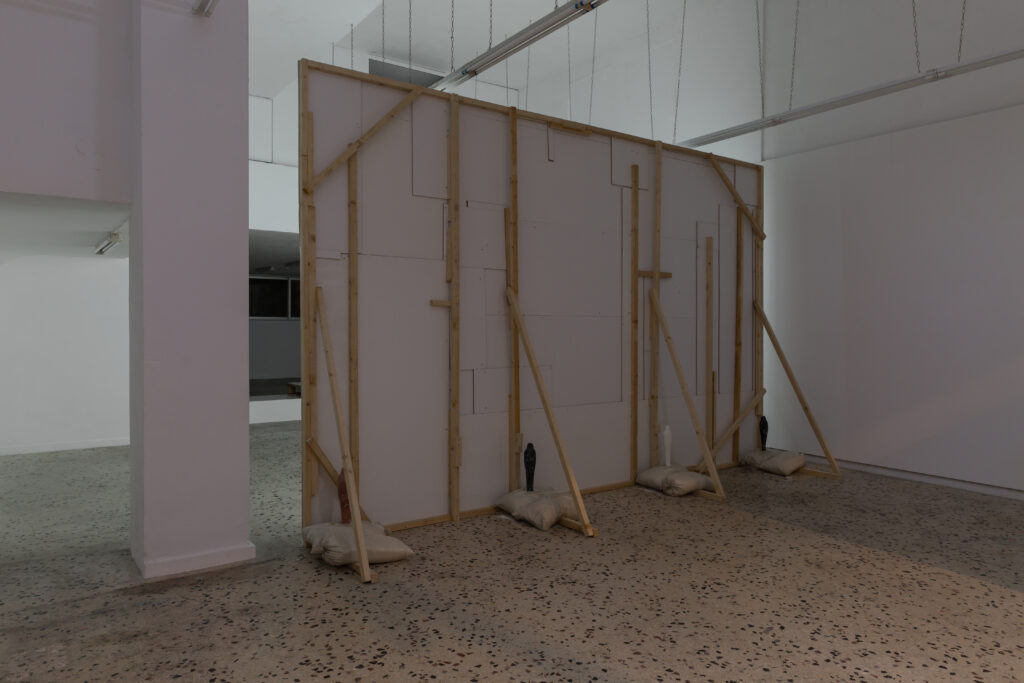
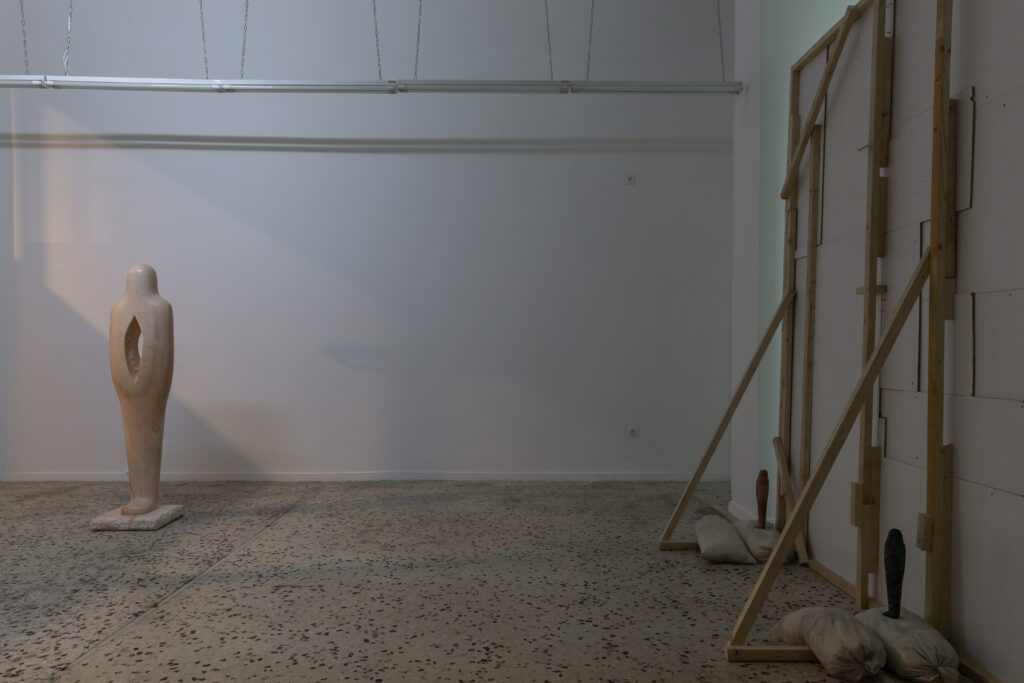
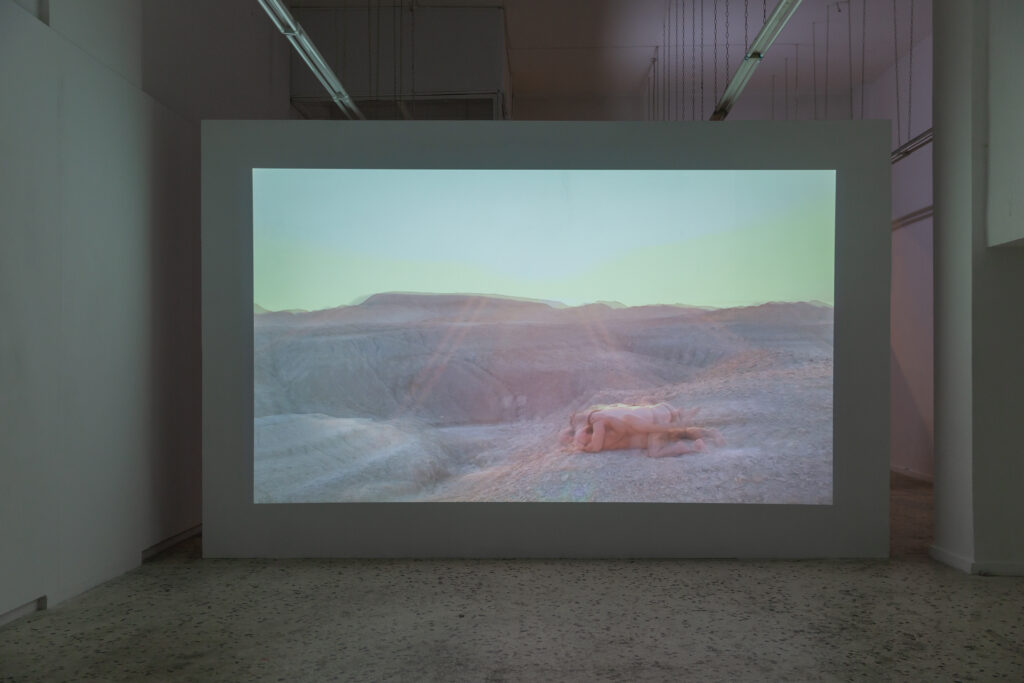
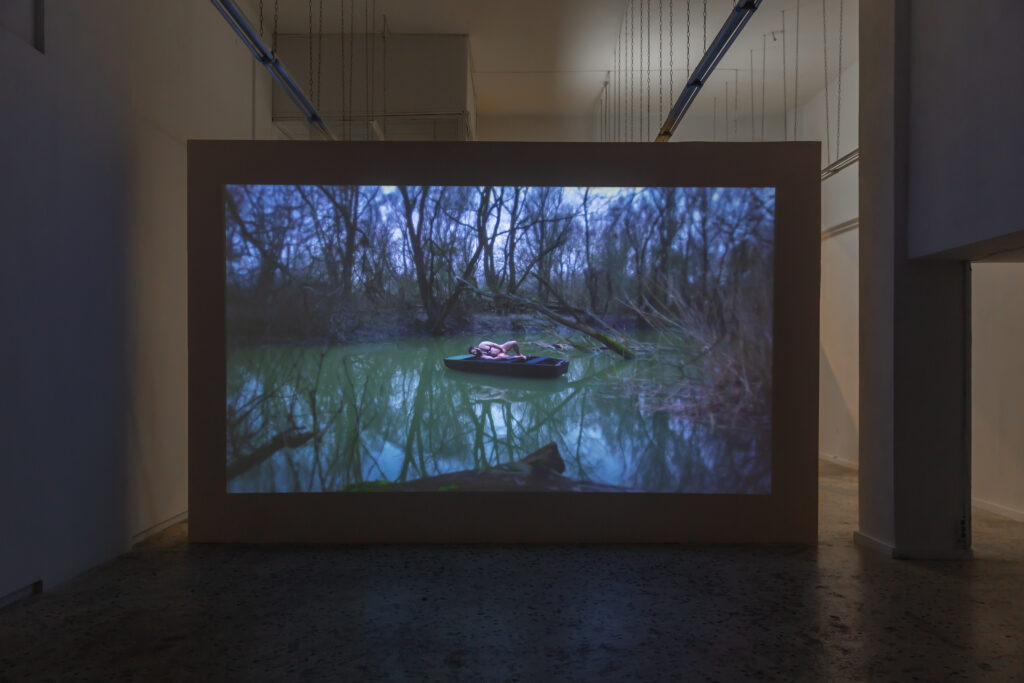
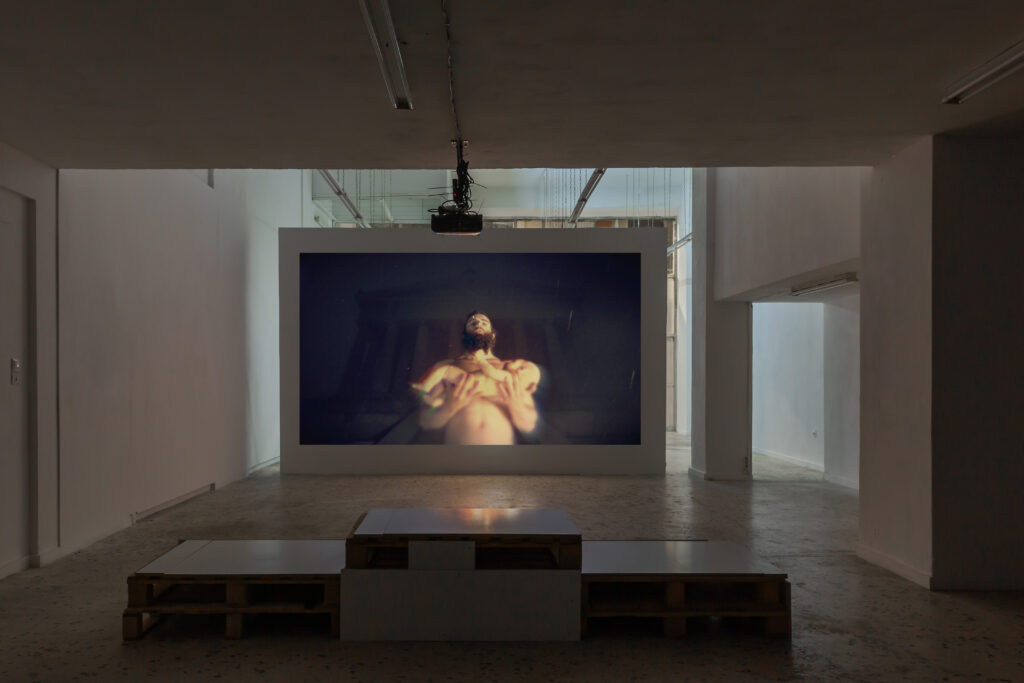
Curated by Asya Yaghmurian
November 25th – December 16th, 2023
Extended by appointment only until 07/01/2024
A group of sculptures, hewn from metamorphic marble, greet the exhibition visitors. One stands at adult human size; the smaller ones dispersed, conveying a familial tableau or a faction in formation. All titled the same—Omphalos—these sculptures lack distinct body parts, sexual characteristics, aging signs, or facial expressions. Sleek and ghostly, they exude an otherworldly elegance, neither benevolent nor militant, seemingly suspended in a state of neutral grace.
Omphalos, meaning ‘navel’ in Greek, denotes the world’s center. The sculptures stand as ego objects, mirroring the form of a sarcophagus (in ancient Greek, sarkophágos translates to ‘flesh-eating’), a limestone coffin believed to consume corpses.
Omphalos–a stone initially veiled by Rhea in cloth, takes the guise of infant Zeus to deceive the overbearing Titan Kronos–matured to adult size. Taking on the ethereal form of a spectral figure, Omphalos by Scoufaras, it could be argued, owes its existence to destruction—a sacrificial offering for civilization.
The ambiguity surrounding the sculpture, as if veiled or shrouded, creates a space for projecting hidden desires. These artworks evoke fecundity or its absence, prompting reflection on the reproducibility of the art object and a yearning for self-reproduction. The Omphalos sculptures mark the culmination of The Trilogy of Terror, projected on the screen behind them.
Metaphorically spanning from ancient Greece to today, the trilogy uses kitsch as a language with which Scoufaras operates—a methodology that generates a vocabulary challenging kitsch through persistent engagement. Three films comprising The Trilogy of Terror — Panic, 2014, N, 2016, and Omphalos, 2016 change sequentially throughout the course of the exhibition.
The trilogy was shot during periods of heightened terrorist threats in Europe and the United States. Scoufaras addresses terror as a collective experience, asking how global events communicated through media impact an individualistic society.
Do the acts of violence emerge from a desire for ownership—ownership of land or, perhaps, ownership of myths and symbolism? Do we seek to possess belief systems or are we propelled by them? How do we, collectively, experience terror?
Throughout all three chapters, Scoufaras meticulously adheres to the protocol: attachment to myth, deliberately chosen and decelerated incidental music, the use of non-professional technical devices, and filming amid historically charged landscapes.
Decelerated musical pieces from the impressionist period, written before and during World War I—a time of palpable tension—accompany the trilogy. Panic features Maurice Ravel’s “Daybreak” from “Daphnis et Chloé”, 1912; Nikolai Tcherepnin’s “A Woodland creature awakes…He plays his flute” from “Narcissus and Echo Op. 40”, 1911 in N and Gustav Holst’s “Saturn” from “The Planets”, 1916 in Omphalos.
Arthur Gillet, artist and performer, embodying all three godly creatures—Pan, Narcissus, and Kronos—delivers a perfect performance completing the trilogy.
In Scoufaras’s trilogy, mythology and sexuality are used to explore and mimic the decline and fall of ‘a current moment’. The Trilogy of Terror may leave one seemingly devoid of hope or may represent another instance of externalization of hope—perpetuating the repetition of the same mistakes.
Panic, 2014
November 25th, 18:00-21:00
Stereoscopic single-channel projection, color, 90 minutes
August 2014, sunrise.
Mount Sodom, Judaean Desert, Israel.
According to the BBC, in the summer of 2014, Israel launched Operation Protective Edge in response to the rocket attacks from the Gaza Strip.[1]
Sodom Mountain, an eight-kilometer-long and five-kilometer-wide mountain range stretching along the southwestern coast of the Dead Sea, takes its name from the biblical city of Sodom, which was destroyed by God for the wicked sins of its inhabitants.
Two men choreographically re-enact a statue of the demigod Pan copulating with a she-goat. The statue survived a cataclysm in Herculaneum during the 79 AD Vesuvius eruption, and distinct from Sodom and Gomorrah, endured “brimstone and fire from the Lord out of heaven” (Genesis 19:24).
The film’s title, Panic, finds its origins in the early 16th century, originating from French panique, modern Latin panicus, and Greek panikos – all associated with the god Pan, who was known for instilling fear and hysteria in the enemy. Panic also evokes “panic sex” – intercourse driven by lust and pleasure instead of the reproductive urge.
Similar to Pan, known for his entrancing music, Scoufaras manipulates the famous “Daybreak” from Maurice Ravel’s choreographic symphony “Daphnis et Chloé”, 1912. Featuring magical harps, flutes, clarinets, and strings, “Daybreak” is decelerated from six minutes to ninety and dramatically connects to a feeling of ecstatic emergency.
The original ballet depicts Chloé being saved by Pan and reuniting with Daphnis, both swearing eternal fidelity, mirroring the lovers in Panic who engage in what seems to be an eternal sexual union. The hypnotic act of anal penetration is transformed into a choreographed performance, with Pan elevated in the air, reminiscent of ballet postures.
N, 2016, December 2nd, 18:00-21:00
Monoscopic single-channel projection, color, 90 minutes
February 2016, dusk.
A creek stemming from the Danube River next to the Hungary-Austria border.
The 2015-2016 migrant crisis brought approximately 5.2 million refugees and migrants to Europe from war-torn regions like Syria, Iraq, and Afghanistan. As reported by Al Jazeera, in 2016 alone, more than 140,000 people entered Hungary at the EU border with Serbia[2].
Amidst this crisis, Hungary built a wall along the border with Slovenia and called for fence construction on the northern border of Greece, as reported by Deutsche Welle[3]. Austria, facing the potential formation of a right-leaning coalition, also tightened its borders.
The film portrays a motionless male body lying on a boat, set against a landscape devoid of signs of life. N, akin to Narcissus, finds an ideal spot for self-reflection in a romantic setting seemingly untouched by any living creature. As told by Ovid, the reflection of Narcissus is only comparable to the beauty of a marble statue. Unable to tear away from his reflection, N engages in onanism and submerges into the water, embracing his symbolic deathbed.
“A woodland creature awakes…He plays his flute” from Nikolai Tcherepnin’s “Narcissus and Echo, Op. 40”, 1911, another choreographic symphony for Ballets Russes, stretches over Arthur Gillet’s strenuous endurance performance in extreme conditions at 4 degrees Celsius.
The ballet’s second track sketches a forest full of shadows and mysteries awakening to the sound of a flute and joining in a joyful bacchanalia. In Scoufaras’ synchronized interpretation, everything appears the opposite; darkness consumes the surroundings, and the scent of terror permeates the air.
But what about Echo, who was desperately in love with Narcissus? Is her presence reflected in the music? Did she curse Narcissus not to be ever able to possess the object of his passion?
Omphalos, 2016, December 9th, 18:00-21:00
Monoscopic single-channel video projection, color, 90 minutes
February 2016, night.
Walhalla, a memorial on Mount Bräuberg, district of Regensburg, Bavaria, Germany.
The Walhalla is a monument, a purely romantic construction that sits atop the hill above the Danube River. Favored during the Nazi rule, the semi-taboo building is not widely known or promoted in Germany today.
According to the official guide from 2002, the Hall of Fame was built between 1830 and 1842 by King Ludwig I to honor politicians, sovereigns, scientists and artists of the German tongue[4]. The temple’s neoclassical architecture is a 1:1 interpretation of the Parthenon of Athens and a symbol of 19th-century German identity. Borrowing its name from Norse mythology, the temple aimed to uplift the spirits of the population, serving as a reminder of German heritage after the traumatic events caused by the French occupation.
Emerging from the darkness, Arthur Gillet, as the Titan Kronos, devours his infant, instead of the Omphalos as in Homer’s epic tale. Kronos, having successfully overthrown his father Uranus, kept devouring his newborns due to a prophecy predicting that one of them would ultimately overthrow him, resulting in the loss of his power as the governor of the Universe.
Rhea, Kronos’ wife, tricked him by wrapping an Omphalos stone in cloth thus saving Zeus’s life. The prophecy unfolds, marking a shift from the Golden Age to Zeus’s rule. In the trilogy, Omphalos stands out as the only chapter where Scoufaras goes beyond reinterpretation and staging of the myth; he introduces an alternative narrative.
Omphalos raises questions posed by Scoufaras to himself and the viewers. Questions that subtly linger between the lines. Where does a collective experience of terror and trauma lead us? What are the temples of today? What if…?
One could argue that the trilogy is male-dominated, but so is the nature of myths. Although there are no female characters physically portrayed in the trilogy, their presence is evident throughout the narrative. In Scoufaras’ rendition, Rhea permits Kronos to commit an act of extreme violence, allowing him to kill their newborn Zeus, and thus granting humans an eternal earthly paradise. This act disrupts the continuation of mythology as known to us today, paving the way for a new world order.
Following the story’s development, the surreal interpretation unfolds, granting life or some form of existence to a stone named Omphalos. Born from the void the newborns of Omphalos propose the unknown, unnamed, incomprehensible state, perhaps the closest described as Chaos.
Text by Asya Yaghmurian
[1] https://www.bbc.com/news/world-middle-east-28156268
[2] https://www.aljazeera.com/amp/news/2015/9/5/refugees-begin-arriving-at-hungary-austria-border
[3] https://www.dw.com/en/hungary-to-block-passage-for-migrants-calls-for-fences/a-18999604
[4] Walhalla Memorial official guide booklet, 2002, p. 3